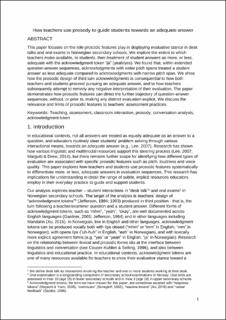| dc.contributor.author | Sikveland, Rein Ove | |
| dc.contributor.author | Solem, Marit Skarbø | |
| dc.contributor.author | Skovholt, Karianne | |
| dc.date.accessioned | 2021-04-22T11:47:39Z | |
| dc.date.available | 2021-04-22T11:47:39Z | |
| dc.date.created | 2020-11-05T09:40:45Z | |
| dc.date.issued | 2021 | |
| dc.identifier.citation | Linguistics and Education. 2021, 61, . | en_US |
| dc.identifier.issn | 0898-5898 | |
| dc.identifier.uri | https://hdl.handle.net/11250/2739138 | |
| dc.description.abstract | This paper focuses on the role prosodic features play in displaying evaluative stance in desk talks and oral exams in Norwegian secondary schools. We explore the extent to which teachers make available, to students, their treatment of student answers as more, or less, adequate with the acknowledgment token “ja” (yeah/yes). We found that, within extended question-answer sequences, acknowledgments with wider pitch spans treated a student answer as less adequate compared to acknowledgments with narrow pitch span. We show how the prosodic design of third turn acknowledgments is consequential to how both teachers and students proceed pursuing an adequate answer, and to how teachers subsequently attempt to remedy any negative interpretation of their evaluation. The paper demonstrates how prosodic features can direct the further trajectory of question-answer sequences, without, or prior to, making any distinct evaluation explicit. We discuss the relevance and limits of prosodic features to teachers’ assessment practices. | en_US |
| dc.language.iso | eng | en_US |
| dc.publisher | Elsevier Science | en_US |
| dc.rights | Attribution-NonCommercial-NoDerivatives 4.0 Internasjonal | * |
| dc.rights.uri | http://creativecommons.org/licenses/by-nc-nd/4.0/deed.no | * |
| dc.title | How teachers use prosody to guide students towards an adequate answer | en_US |
| dc.type | Peer reviewed | en_US |
| dc.type | Journal article | en_US |
| dc.description.version | acceptedVersion | en_US |
| dc.source.volume | 61 | en_US |
| dc.source.journal | Linguistics and Education | en_US |
| dc.identifier.doi | 10.1016/j.linged.2020.100886 | |
| dc.identifier.cristin | 1845117 | |
| dc.relation.project | Norges forskningsråd: 273417 | en_US |
| dc.description.localcode | © 2021. This is the authors’ accepted and refereed manuscript to the article. Locked until 27 November 2022 due to copyright restrictions. This manuscript version is made available under the CC-BY-NC-ND 4.0 license http://creativecommons.org/licenses/by-nc-nd/4.0/ | en_US |
| dc.source.articlenumber | 100886 | en_US |
| cristin.ispublished | true | |
| cristin.fulltext | postprint | |
| cristin.qualitycode | 1 | |

